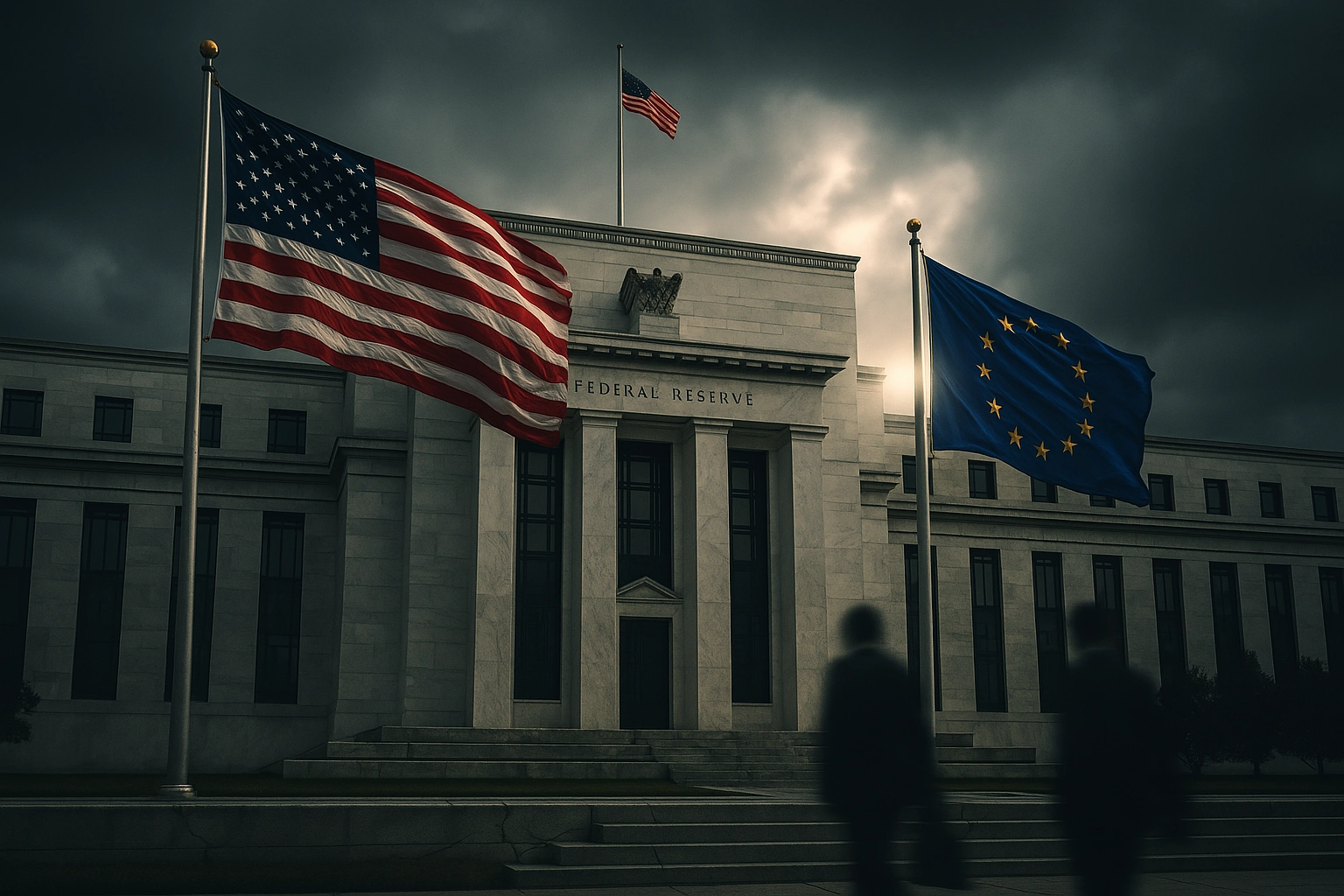
European central bankers are quietly exploring alternatives; reliance on U.S. Federal Reserve dollar swap lines has raised eurozone liquidity risk alarms.
For decades, European financial stability has rested on a crucial assumption: if a dollar liquidity crisis hits, the U.S. Federal Reserve will step in as lender of last resort. Now, some European central banking officials are quietly questioning whether that dollar lifeline can still be taken for granted. Amid shifting U.S. politics and global power balances, they have begun weighing contingency plans in case the Fed’s dollar funding backstops are not readily available in a future crisis. This unprecedented introspection strikes at the heart of global financial stability and underscores mounting eurozone concerns over liquidity risks and US-EU central bank relations.
Key Developments
- Informal Risk Talks: In recent weeks, senior euro zone central bankers and bank supervisors have held informal discussions about whether Europe can rely on the Fed’s dollar swap lines during market stress. These behind-closed-doors conversations – reported here for the first time – reflect a new precautionary mindset in Frankfurt and other European capitals. Officials have been “gaming out” scenarios, even exploring potential alternatives to the U.S. central bank’s funding support.
- Trust Shaken by U.S. Politics: The talks are not driven by any change in Fed or European Central Bank (ECB) policy signals, but by geopolitical jitters. European officials say their trust in Washington’s reliability has been shaken by recent U.S. policies. Former President Donald Trump’s administration, in particular, took an “America First” turn – from appearing to endorse Russia’s stance on Ukraine to imposing tariffs on European allies – sparking doubts about U.S. commitment to global cooperation. One source involved in the talks cited concern about “the potential for less international cooperation on the part of American authorities” going forward.
- Fed’s Dollar Lifeline: At issue is the network of Federal Reserve dollar swap lines – essentially emergency pipelines of U.S. dollars to foreign central banks. In times of severe market stress, the Fed has provided the ECB and other major central banks access to dollar funding, acting as a critical safety net. These swap arrangements, made permanent among six leading central banks in 2013, are widely seen as a bedrock of financial stability. They proved their worth during crises: for example, in the 2008 meltdown the Fed funneled hundreds of billions of dollars overseas to avert a global collapse, and most recently in 2023 the Fed supplied tens of billions of dollars to the Swiss National Bank – enabling Credit Suisse to meet panicked client withdrawals. While Credit Suisse ultimately had to be rescued via takeover, the Fed’s action helped avert an implosion that could have rocked the entire financial system.
- No Easy Substitute: After reviewing worst-case scenarios, European officials reluctantly concluded there is no good substitute for the Fed’s dollar backstop. Other options – such as tapping international institutions or cobbling together regional arrangements – would fall short in scale or speed. The Federal Reserve’s capacity to create U.S. dollars in unlimited quantities is unique. “The takeaway from these discussions: there is no good substitute to the Fed,” one official summarized. Despite this reality, the very act of European planners questioning an American financial backstop signals a notable shift in mindset.
- Reassurances and Reality: Publicly, officials stress calm. ECB President Christine Lagarde, speaking in a European Parliament hearing, said the working relationship with Fed Chair Jerome Powell “had not changed” since Trump took office in January, reaffirming that U.S.-European central bank ties remain solid. The Fed, an independent institution accountable to Congress, has never hinted it would withdraw liquidity support and sees swap lines as protecting the U.S. economy from foreign financial contagion. Indeed, multiple European central bankers emphasized it’s “highly unlikely” the Fed would ever refuse to honor its dollar funding backstops. Nonetheless, the informal eurozone discussions are expected to surface in more formal policy circles soon, as officials grapple with how to bolster eurozone liquidity without assuming an always-benevolent Fed.
Political Impact
European unease over dollar reliance is rooted in politics as much as economics. The Trump era marked a strain in transatlantic trust, and its legacy is influencing central bankers’ risk assessments. President Trump’s unconventional policies – from questioning NATO security commitments to slapping tariffs on EU steel – jolted European confidence in U.S. support. Now, even with an ostensibly independent Fed, some Europeans fear a more isolationist U.S. stance could indirectly curtail the spirit of cooperation that underpins emergency swap lines.
Several European officials voiced concern that a U.S. administration could pressure the Fed to limit aid to foreign institutions in a crisis. The Fed’s mandates are domestic, and while it has a history of international coordination, a hostile political climate might influence its willingness to extend help. Four of the six sources who spoke to Reuters said it’s conceivable that over time the Trump (or any nationalist) administration might try to lean on the Fed – eroding the unwritten pact of support. The Fed’s leaders are appointed by the U.S. president, which means a government intent on a hardline stance could slowly reshape the Board’s outlook. As Deutsche Bank analysts noted, the White House can exert “indirect influence via moral suasion as well as appointments” to the Fed, potentially affecting policy at the margins even if outright interference is unlikely.
This simmering anxiety reveals how political rifts are encroaching on what used to be technocratic realms. US-EU central bank relations have traditionally been strong – the Fed and ECB communicate frequently and have coordinated moves during global crises. (Notably, the permanent swap line network among the Fed, ECB, Bank of England, Bank of Japan, Bank of Canada and Swiss National Bank is a tangible legacy of post-2008 G7 unity.) That makes the current doubts striking: they hint at a fracture, or at least a hedge, within the normally united front of Western central banks. “It’s a sea-change in ties between the U.S. and European allies,” observes Jane Foley, head of FX strategy at Rabobank, regarding European officials even raising the question. She attributes it squarely to the Trump era’s disruptive influence: “Trump’s trade and foreign policies have forced Europe on a path towards reduced reliance on the U.S., and this likely implies a desire for reduced reliance on the dollar,” Foley said. In other words, geopolitical fault lines are pushing Europe to consider financial independence measures that were previously unthinkable for close allies.
From the perspective of the Group of Seven (G7) advanced economies, such introspection is unusual. The G7 central banks have long operated on mutual trust and reciprocal backstops. However, Europe’s newly cautious stance mirrors feelings more commonly voiced in emerging markets. It underscores that concerns about over-reliance on the U.S. dollar are no longer confined to the BRICS or the Global South – they have seeped into the halls of Frankfurt, Paris and Rome. The political impact is a subtle realignment: Europe isn’t abandoning the U.S., but it is hedging its bets, much as countries like China or India have begun to do in recent years.
Economic Outlook
While the scenario of the Fed failing to extend its dollar swap lines is considered remote, its implications would be enormous – and not just for Europe. Eurozone liquidity risks would spike instantly. European banks have roughly 17% of their funding denominated in U.S. dollars, according to an ECB study, reflecting decades of globalization in trade and investment. Much of this dollar funding is short-term: money market loans, commercial paper, or forex swaps that must be continuously rolled over. In a crisis, if those dollar funding markets seize up (as happened in 2008 and again briefly in 2020), banks scramble to obtain dollars to meet obligations. The Federal Reserve’s swap lines have been the pressure valve in such moments, swiftly providing dollars to central banks like the ECB, which in turn on-lend to banks. Should that valve be shut off, the effects could be severe. “Without the Fed backstops, in the short term the dollar liquidity scramble would drive dollar funding costs higher, leading to a sharp appreciation of the U.S. dollar,” Deutsche Bank strategists wrote in a note, envisioning a worst-case scenario. In other words, the euro (and other currencies) would plummet in value relative to the dollar as demand for the greenback soars – making it even harder for European firms to obtain affordable dollars.
The contagion wouldn’t stop at Europe’s borders. Financial stress would quickly spread to U.S. markets as well. European banks and investors, unable to borrow dollars, might dump U.S. assets to raise cash, potentially triggering “a fire sale of U.S. assets” and liquidity problems on Wall Street. Global investors, seeing the Fed back away, would likely panic, dumping stocks and bonds across regions. Several European officials noted that any Fed decision to curtail swap lines would almost certainly ricochet back onto the U.S. economy, imperiling the very financial stability the Fed seeks to protect. It could even threaten the dollar’s long-run dominance if trust in U.S. commitments eroded.
Fortunately, nearly everyone involved deems this a highly unlikely, almost doomsday scenario. The Federal Reserve has strong incentives to keep the dollar spigots open for allies: doing so not only preserves global stability but also maintains confidence in the dollar-centric financial system. The bar for the Fed to withhold its liquidity support is “exceptionally high,” according to Deutsche Bank’s analysis. Fed Chair Jerome Powell has in the past affirmed the importance of these international swap lines as a first line of defense against global crises spilling into the U.S. homeland. The Fed’s independence acts as another bulwark – it would take extraordinary pressure for political forces to override the central bank’s judgment in a crisis.
Yet, from an economic risk management perspective, Europe cannot ignore even a remote tail-risk. The very exercise of considering a world without the Fed’s safety net is prompting eurozone regulators to re-examine vulnerabilities. Banks may be encouraged to reduce their structural dollar mismatches – for instance, by lengthening the maturity of dollar funding or by holding larger dollar liquidity buffers. European supervisors already monitor banks’ foreign currency liquidity closely, and this episode could lead to even stricter oversight on dollar funding dependence. The ECB’s routine “vulnerability analysis” now pointedly includes the availability (or theoretical loss) of Fed swap support. In parallel, there’s renewed discussion in Europe about boosting the global role of the euro to diminish reliance on the dollar over time. (The euro currently accounts for roughly 20% of global foreign exchange reserves, compared to nearly 60% for the U.S. dollar – a gap that has narrowed slightly in recent years as the dollar’s share has declined.) EU officials have periodically floated initiatives to increase euro-denominated trade in energy and commodities, develop deeper European capital markets, and even explore digital euro offerings, all aimed at strengthening the euro’s international standing and resilience.
Another outcome of Europe’s soul-searching is closer engagement with other central banks. If U.S. support might be less assured, coordination among the G7 and beyond becomes even more vital. We may see Europe engaging more with partners like the Bank of England, Bank of Japan and others to ensure swap lines and liquidity facilities are robust in all directions. During the 2020 pandemic turmoil, the Fed extended temporary dollar swaps to central banks in several advanced and emerging economies (such as Australia, Brazil, South Korea and Mexico) to stave off a dollar crunch – a broad-based support that would be politically harder to replicate under an isolationist doctrine. In that episode, as in 2008, swift Fed action stabilized markets. The current consensus is that the Fed will continue to act pragmatically in any future crisis, regardless of political noise. But the economic outlook now features a subtle new variable: a sliver of doubt in the continuity of U.S. lender-of-last-resort support. This has injected a cautionary note in boardrooms and finance ministries across Europe. It’s a reminder that even in an interconnected global system, external assumptions warrant stress-testing.
What’s Next?
European policymakers are approaching this issue delicately, recognizing its sensitivity. In the coming months, the question of dollar liquidity backstops is expected to be raised in more formal international forums. The topic could surface during G7 finance meetings or at the International Monetary Fund’s spring gathering, where finance chiefs often discuss global safety nets. Don’t expect any public bust-up – these discussions will likely remain low-key. No one wants to spark market fears about a rupture in U.S.-European financial cooperation. However, behind the scenes, contingency planning will continue. Eurozone authorities may consider coordinating with the U.S. Treasury and Federal Reserve to seek quiet assurances or understand potential red lines. They will also continue engaging in “war games” of sorts – running simulations of a liquidity crisis without the Fed, to see how the system would cope and what stopgaps could be put in place (such as tapping the IMF’s emergency facilities or activating regional arrangements).
On the political front, European leaders might seek to institutionalize assurances of Fed support. While the swap line network is already standing, there could be discussion of codifying its usage during crises in a more explicit way. This might involve updated memoranda of understanding between the Fed and its counterpart central banks, affirming the principles of support. Such moves would be subtle and technical, but they could serve to reassure European officials without any overt political statements. Meanwhile, the ECB will keep a close eye on U.S. politics. As the U.S. heads into its next election cycle, any rhetoric about isolationism or “decoupling” will be noted by central bank risk assessors.
In the banking sector, expect firms to quietly prepare as well. Banks might begin to diversify their liquidity sources just in case, securing backup credit lines in various currencies and jurisdictions. Some European banks could reduce short-term dollar borrowing or increase issuance of dollar bonds with longer maturities (locking in funding to be less exposed to sudden freezes). Affected sectors like international lending and trade finance will lobby for safety nets to remain robust – dollar funding is their lifeblood. For example, big European lenders in commodity trade (an area heavily dollarized) will want central banks to guarantee that dollars will be available in a pinch. Companies in the eurozone have learned from the close call with Credit Suisse and from past crises that liquidity can vanish overnight. This hard-earned lesson is driving a more proactive stance.
Globally, if European concerns persist, we could see renewed momentum towards a multipolar currency system. Already, talk of “de-dollarization” is growing louder in parts of the world. If even U.S. allies are hedging on dollar dependence, that narrative strengthens. Ironically, the mere hint that Washington might one day use the dollar’s privileged position as a bargaining chip could spur others to accelerate plans to diversify away. “If such a withdrawal [of Fed support] became a concern it would likely create pressure for the rest of the world to de-dollarize more rapidly,” the Deutsche Bank analysts wrote. In the long run, that could mean a more fragmented global financial order – something U.S. policymakers have long tried to avoid.
For now, no rupture has occurred. The status quo holds: the Fed’s swap lines remain open and European officials still view the likelihood of U.S. dollar support disappearing as “very remote”. The immediate next step is likely a series of quiet transatlantic conversations to solidify trust. The situation bears close watching, however. Europe’s introspection may mark the start of a slow but significant strategic shift in how nations insure themselves against financial shocks. It is a story of prudent planning – and a subtle signal to Washington that the post-war framework of global finance, with the U.S. dollar at its core, should not be taken for granted.
Quick Insights
- European Doubts Emerge: A handful of European central banking and regulatory officials have privately questioned the reliability of Federal Reserve dollar swap lines in a crisis, reflecting new caution in the eurozone.
- Trust and Politics: These discussions are driven by shaken trust in U.S. policies under an isolationist tilt. European allies worry that political pressure in Washington could one day curb the Fed’s support, testing long-standing US-EU central bank relations.
- No Ready Replacement: After exploring options, officials found no real alternative to the Fed’s dollar liquidity backstop. The U.S. dollar remains the world’s reserve currency, comprising roughly 60% of global reserves, and no other institution can fill the Fed’s role at scale.
- Financial Stability at Stake: Fed swap lines are seen as vital to global financial stability. In 2023, for example, Fed swaps funneled tens of billions of dollars to Switzerland, helping Credit Suisse weather a bank run. Losing this support is deemed a very remote risk – but one with catastrophic potential, including dollar funding crunches and market contagion.
- Strategic Hedge: Europe’s quiet contingency planning aligns with a broader global trend toward hedging dollar dependence. Whether through boosting the euro’s international role or engaging with emerging powers, even America’s allies are seeking insurance as a new era of financial geopolitics unfolds.
Regional Spotlight: BRICS and the Dollar Dilemma
The unease about dollar reliance isn’t confined to Europe. Across the BRICS nations – Brazil, Russia, India, China, and South Africa – and other emerging economies, reducing dependence on the U.S. dollar has been a strategic goal for years. This “de-dollarization” drive has multiple motives: shielding economies from U.S.-centric shocks, avoiding the impact of Western sanctions, and asserting financial sovereignty. Recent U.S. isolationist signals only add impetus to these efforts.
China, for instance, has established its own web of bilateral currency swap lines (with over 30 countries) to facilitate trade in yuan and provide partner central banks with emergency liquidity in Chinese currency. Beijing and Moscow have increasingly conducted energy trade in rubles and yuan, especially since Russia faced U.S. financial sanctions — a survival tactic that has side benefits of undermining dollar hegemony. Russia, having been largely cut off from dollar markets, accelerated a shift to alternate currencies and even cryptoassets for some transactions, while shoring up its gold reserves. India has launched arrangements for settling trade with certain partners in Indian rupees, aiming to reduce dollar outflow and exposure to U.S. monetary tightening. Meanwhile, the BRICS bloc collectively set up a $100 billion Contingent Reserve Arrangement in 2015 – a joint emergency fund designed to provide liquidity support to members in case of currency crises. They also founded the New Development Bank (NDB), a multilateral lender intended to fund projects in local currencies as an alternative to dollar-funded institutions.
So far, these initiatives only dent the surface of global dollar dominance. The dollar’s grip on international finance – from trade invoicing to debt markets – remains robust. But momentum is building. At the August 2023 BRICS summit in Johannesburg, members discussed increasing the use of local currencies and even floated the long-term idea of a BRICS common currency (though experts see that as far-fetched for now). G7 vs. BRICS: Interestingly, the current concerns of European officials echo arguments long made by leaders in the Global South. Where G7 economies historically trusted U.S. stewardship of the world’s reserve currency, BRICS nations were more skeptical, citing the risk of the dollar being “weaponized” or withheld. Now, with Europe voicing its own doubts (albeit hypothetically), the gap between Western and emerging perspectives may be narrowing. If U.S. policymakers turn more inward, it could end up validating the BRICS viewpoint and spurring a faster pivot away from the dollar in many parts of the world.
From a regional standpoint, Europe’s situation and the BRICS response highlight a common theme: the search for financial safety nets that don’t hinge on U.S. policy. While Europe still operates within a U.S.-led framework (the swap lines, the IMF, etc.), BRICS countries are building parallel frameworks. Should the Fed’s swap lines ever come into question, Europe might even look to some of these frameworks – for example, closer financial coordination with China or tapping into global liquidity pools – though such moves would mark a historic realignment. In any case, the dollar dilemma is now front and center for regions worldwide, from the Eurozone to East Asia to Africa. The coming years could see a mosaic of solutions: strengthened alliances among central banks, increased use of alternative currencies, and new institutions to support liquidity. The BRICS experience shows both the promise and limitations of going it alone: while they have reduced some dollar usage, the U.S. currency remains deeply ingrained. Europe, with its economic heft, could lend significant weight to the de-dollarization trend if it ever chose to actively pursue it. For now, Europe prefers to gently hedge rather than overhaul the system. But the very fact that Frankfurt is pondering questions that preoccupy New Delhi or Beijing is a telling sign of the times.



